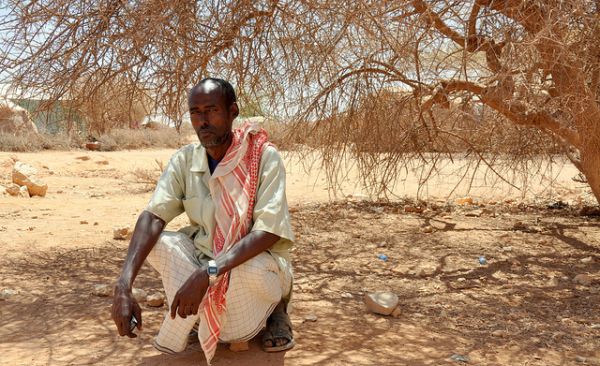
by Alun McDonald, Media and Communications Officer, Horn East & Central Africa
For years the villagers of Waridaad have sat and sipped cups of sweet, milky tea in Khadija Acoil’s wooden teashop. There they take a break from work, escape the burning midday sun, and chat about the latest village news.
“It’s very hot here and we Somalis use a lot of sugar as a source of energy. We drink a lot of tea throughout the day,” says Raewi Awil Araale. But these days the tea is weaker, there are fewer people to talk to, and there is only one topic of conversation – the drought that has left animals dead, people thirsty, and the price of food higher than ever.
Khadija’s shop used to open “all day, every day.” Now she often closes because she has no customers, or no ingredients. She has to use canned milk – “There is no fresh milk available because so many animals have died” – and less sugar and tea in each cup. “My customers don’t like it so much, but I have no choice.” A kilo of sugar that cost $1.60 a few months ago now costs $2.50.
The rising cost of living is affecting everyone in the village. Raewi runs a small shop across the road and has had to put up her prices. Rice – along with sugar her main stock – is up from $1 to $1.40 per kilo, and rising. “I used to sell 50kgs of rice in a couple of days,” she says. “Now it takes a month to sell that much – people just can’t afford it.”
Most of the men who come to drink tea or buy food – like the majority of people in this perennially dry region – make their living from livestock. Hirsi Farah Ali says he has lost nearly two thirds of his sheep, goats and camels since January. “They all died from hunger and disease. We had nearly 12 months without any rain at all. All the water sources dried up – the pasture went too. Water and pasture – these are the two things we pastoralists rely on.”
Without their cattle families have no money, meat or milk.
Some have changed their diet – Raewi sells more maize than rice now, which is unusual in this predominantly pastoral region. But it’s cheaper and can be fed to both animals and humans. Others have cut back on meals. Fadoomo Hirsi, a widow looking after four children, two grandchildren and an elderly mother, says her family now eat two meals a day instead of three. The pasta, dates and meat they ate for dinner are now scarce or prohibitively expensive.

Aden Jama used to live 10kms from the village, where he and his two wives looked after their 220 sheep and goats and 12 camels. Now, he says, only a quarter remain and the family has moved to within a kilometre of the village to be closer to the water that Oxfam’s partners – the Somali organisation Havoyoco – have been trucking in daily. He worries about the health of his children:
“In the past the children had milk from the animals. Now they have nothing. They are still ok for now, but you can see them getting weaker. It is almost six months since they ate meat or vegetables. Relatives send us food – we mainly eat rice twice a day, and sometimes maize, tea, flour and bread.”
In the absence of any official social security, the tight-knit community comes together to help the most vulnerable. Better-off relatives buy food for families like Aden’s, and shopkeepers like Raewi and Khadija sell goods on credit. “Most of my customers are rural people,” says Raewi, “and now they don’t have any money because of the drought. I give them what they need and then when it rains – if it rains – and their sheep become strong again they will pay me back.”
Together with Havoyoco’s and Oxfam’s efforts, people are struggling to get just enough food and water to survive. But malnutrition is rising across Somalia, and three young children – two of them less than a year old – died in Waridaad recently from diarrhoea. Thousands of animals have died too.
The drought is also affecting the future of the younger generations. Ali Hussein is the principal of the village school, where attendance has dropped by a quarter as the drought has got worse. “There were 188 children – now there are just 142,” he says. “The rest have stopped coming. There is no water and no food here and when life becomes too difficult the children stay at home.”
Others move with their families to try and find water and pasture. According to the UN around 400 schools have had to close since December across Somalia, affecting 55,000 children.
Find out more about the food crisis in Africa, the result of the worst drought in 60 years
Donate to our Africa Food Crisis appeal